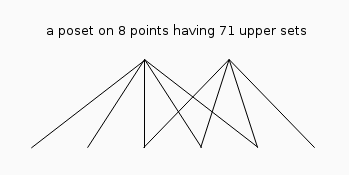You start with a finite set B of cardinality k. Next you consider its power set P(B) which is by definition the set of all the 2k-many possible subsets of B. Then a finite topologic space S is any subset of such a powerset which satisfies the following two conditions: It must contain the empty set and the set B and secondly for any two elements of S it must be closed under intersection and union.
You may translate this definition of finite topologies into binary 0-1-strings of length k. Then the intersection becomes the binary and-operation and the union the binary or-operation on the strings. Lastly, denote the number of elements of S, which are called open sets, by n.
Then one may ask: At least how many elements k must a set contain such that a finite topologic space on it can exist which consists of exactly n open sets?
This unique sequence of numbers (m(n))n starts as 0,1,2,2,3,3,4,3,4,... like the sequence of the length of shortest addition chains (ℓ(n))n. As a matter of fact for all n ≤ 128 with n ≠ 71 holds ℓ(n)=m(n) but 9 = ℓ(71) > m(71) = 8.
Because there is a on-to-one mapping of finite topologic spaces to preorders of finite sets, we also can consider preorders. Define for any x, y ∈ B a natural preorder on a topologic space as x ≤ y if the closure of x is a subset of the closure of y. The closure of any element x ∈ B is defined as the intersection of all open sets of the topologic space which contain x.
Notice, because we are interested only in the minimal number of points of a topologic space, we can restrict to non-isomorphic T0-topologies, i.e. all points must be topologically distinguishable. And then finite preorders become finite posets, i.e. finite partial order sets. The upper sets (upwards closed sets) of a poset, correspond one-to-one to the open sets of the associated T0-topology. Any poset may be represented by a directed graph where the vertices correspond to the points/elements and its directed edges correspond to the order-relations. If this graph is drawn on a piece of paper such that the parents of points are always above their children, then we can omit the directions of the edges in this picture. As an example the minimal poset with ℓ(n) ≠ m(n) is presented next:

If you delete both top points the 6 remaining points have no relations and generate 26 upper sets. Adding then only the left point give rise to (25+1)21 upper sets, on the other hand adding then only the right point give rise to 22(24+1) upper sets. Finally adding the last removed point left adds 22+1 respectively on the right adds 21+1 further open sets. This poset and its dual poset (where all order-relations are inverted) are the only posets on 8 points having 71 upper sets.